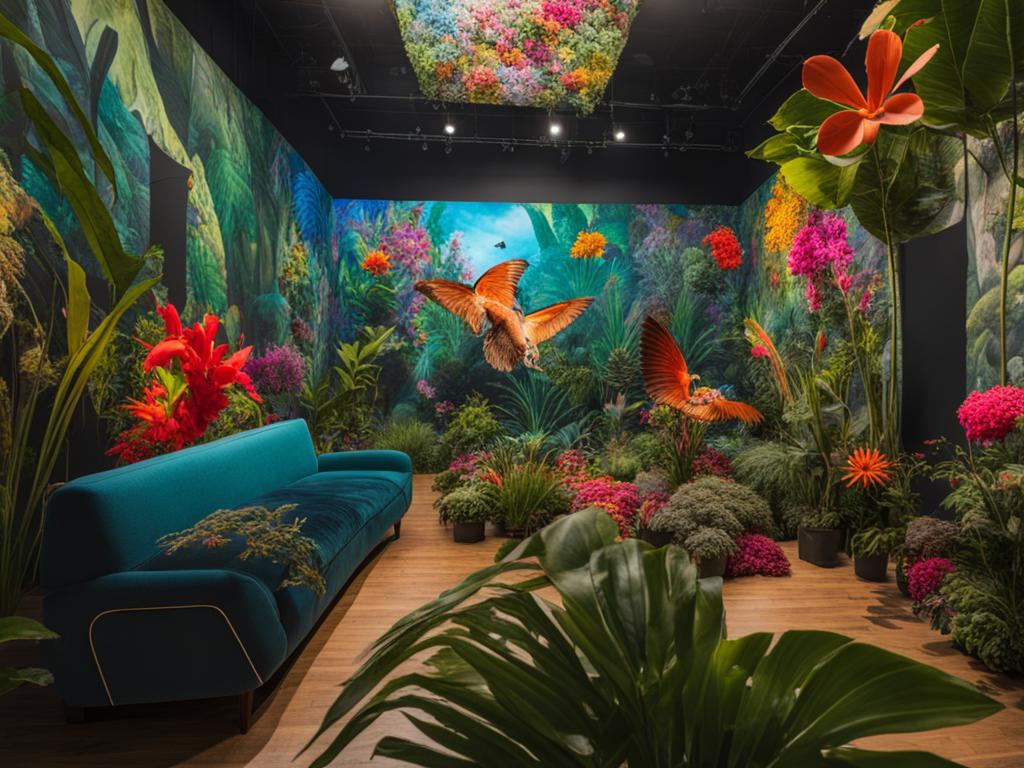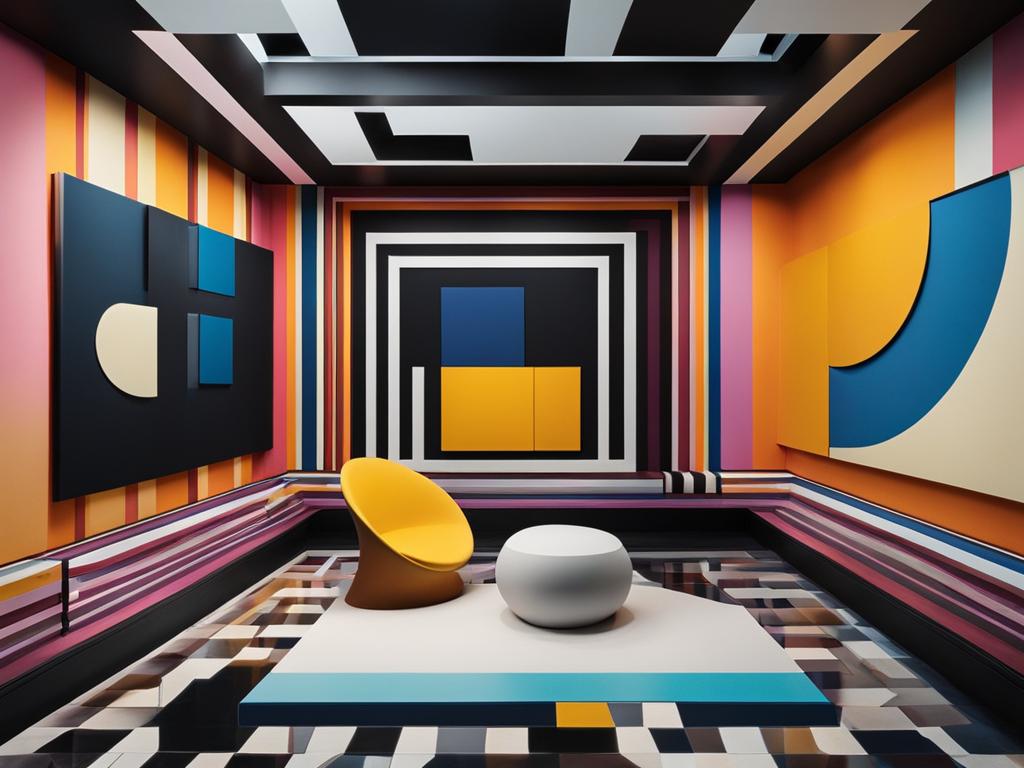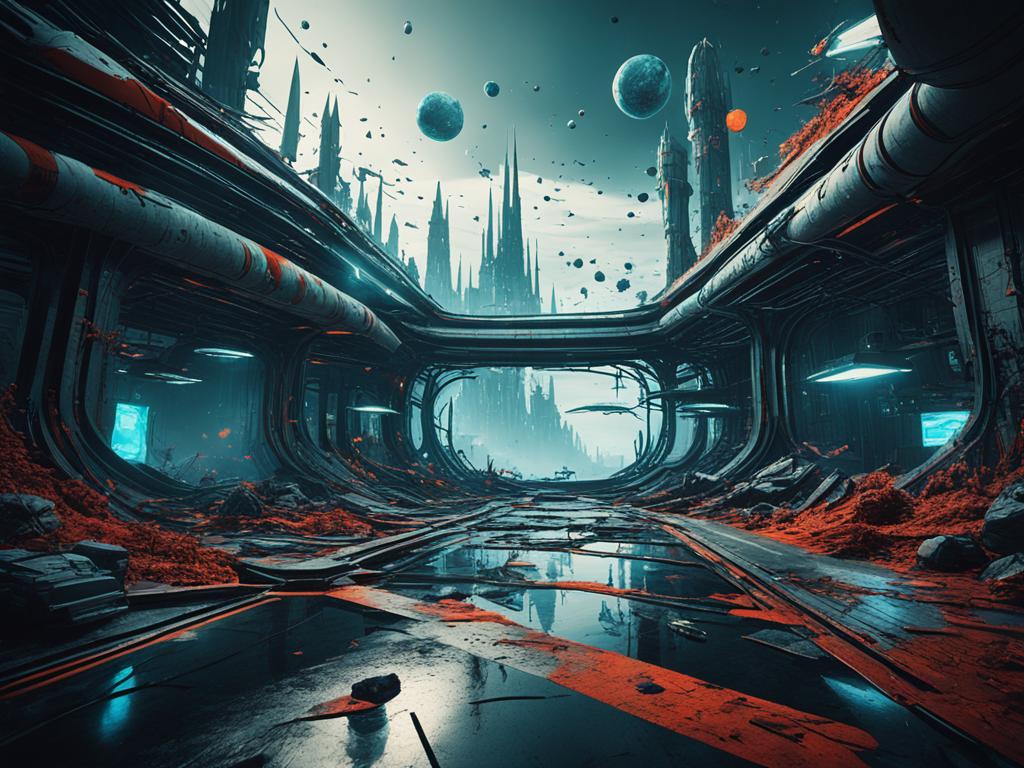Virtual reality art installations are transforming the way we perceive art and interact with our surroundings. As a professional copywriting journalist, I have witnessed how these installations have created powerful and immersive experiences for viewers.
In this article, I will explore the evolution of virtual reality art, the techniques used by virtual reality artists, and the impact of virtual reality art on the art world. We will also look at virtual reality art galleries and exhibitions, immersive art experiences in virtual reality, and the intersection of virtual reality and augmented reality in the world of art. With captivating sensory experiences and thought-provoking social commentary, virtual reality art installations are quickly becoming a medium of artistic expression in their own right.

Join me as I take a closer look at how virtual reality art installations are shaping the art world and expanding the possibilities of artistic expression.
The Evolution of Virtual Reality Art
The use of virtual reality technology to create cutting-edge art installations is a relatively recent trend, but it has its roots in a long history of experimentation. From the stereoscopes of the 19th century to the early computer-generated virtual reality experiences of the 1980s, artists have always been interested in pushing the boundaries of what is possible with new technologies.
However, it wasn’t until the development of affordable and accessible VR hardware and software that virtual reality art began to truly take off. One of the pioneers in this field was Char Davies, a Canadian artist who created the interactive installation Osmose in 1995. This immersive experience allowed participants to explore different virtual environments, using breathing as a way to control their movements within the space.
Since then, VR art has continued to evolve rapidly, with artists exploring new techniques and technologies to create more immersive and interactive experiences. One of the key developments has been the use of haptic feedback, which allows participants to feel physical sensations as they interact with the artwork. Another important trend has been the integration of AR (augmented reality) elements into VR installations, blurring the boundaries between the virtual and the physical worlds.
“Virtual reality art is a medium that offers artists a new set of tools for creating captivating and engaging experiences for their audiences. As the technology continues to improve, we can expect to see even more innovative and thought-provoking installations in the years to come.”
Today, a variety of artists are working with VR technology to create stunning and memorable installations. Some of the most celebrated VR artists include Laurie Anderson, who created the VR performance piece Chalkroom, and Marshmallow Laser Feast, a UK-based collective that creates immersive installations that combine VR with other mediums, such as dance and soundscapes.
| Name | Notable Works |
|---|---|
| Char Davies | Osmose, Ephémère |
| Laurie Anderson | Chalkroom, The Boat |
| Marshmallow Laser Feast | We Live in an Ocean of Air, IRIS: A Journey Through the World of Cinema |
As technology continues to improve, we can expect to see even more groundbreaking VR art installations in the future. Whether it’s through immersive sensory experiences, interactive storytelling, or social commentary, virtual reality art is a medium that offers artists a new set of tools for creating captivating and engaging experiences for their audiences.
Techniques in Virtual Reality Art
Virtual reality artists are constantly pushing the boundaries of what is possible in art and technology. They use a variety of techniques to create immersive digital art experiences that engage and captivate viewers. One of the key techniques used is the digital toolset, which includes software applications and hardware devices that allow artists to create and manipulate 3D objects and environments.
Another popular technique in virtual reality art is the use of interactive elements. These elements allow viewers to become active participants in the artwork and influence the direction of the experience. For example, an artist may create a virtual environment where viewers can explore and interact with different objects or characters, affecting the narrative or outcome of the piece.
An emerging trend in virtual reality art is the integration of augmented reality into virtual reality installations. By combining these two technologies, artists can create even more immersive and dynamic experiences. Augmented reality elements can enhance the realism of virtual objects, making them appear to interact with the real world.
Through these techniques and more, virtual reality artists are creating mind-bending digital art experiences that challenge traditional artistic limits and push the boundaries of technology and creativity.
The Impact of Virtual Reality Art on the Art World
The emergence of virtual reality art installations has had a profound impact on the art world, challenging traditional notions of artistic expression and pushing the boundaries of creative possibility. Virtual reality has brought new dimensions to the viewer experience, creating immersive and interactive installations that engage the senses and transport the viewer to new worlds.
The art world has taken notice of this cutting-edge medium, recognizing virtual reality installations as a new form of contemporary art. Institutions such as the Smithsonian American Art Museum and the Museum of Modern Art have featured virtual reality installations in their exhibitions, cementing their place in the canon of contemporary art.
Virtual reality art offers artists a new mode of expression, allowing them to create installations that defy the limitations of physical space and traditional mediums. It provides a platform for experimentation and exploration, where artists can push the boundaries of their craft and captivate audiences with their creations.
As virtual reality technology continues to evolve and become more accessible, it is likely that we will see even more exciting and innovative virtual reality art installations in the future. The art world will continue to be enriched by this dynamic and transformative medium, expanding the possibilities of artistic expression and enhancing the viewer experience.
Virtual Reality Art Galleries and Exhibitions
Virtual reality exhibitions and galleries have emerged as new, cutting-edge platforms in the art world, offering innovative ways to showcase digital art experiences of virtual reality artists, providing a unique viewer experience of artistic creations, and enabling a greater degree of access to these works. By immersing visually stunning and thought-provoking art installations in a virtual space, these galleries allow visitors to navigate the art in a way that exceeds the constraints of physical galleries. This benefits both artists and art lovers alike.
Virtual reality galleries are diverse in size and structure but share the commonality of creating immersive environments that encourage interaction with the art. These virtual spaces are not limited by physical location or accessibility and can reach a broader audience. Emerging artists can showcase their work at less cost than physical galleries, and visitors to these spaces can experience unique and unforgettable virtual reality exhibitions that exemplify a new era of artistic expression.
This trend is fueling increasing interest and investment in the creation of virtual reality exhibitions and galleries. Accordingly, they are fast becoming a crucial way to engage with and experience the art in the 21st century. To find out more about the virtual reality art clamor, take a look at the captivating Table 5.1 below.
| Name of virtual reality gallery/exhibition | Location | Type of art exhibited |
|---|---|---|
| Acute Art | London, United Kingdom | Virtual reality art installations and sculptures |
| The VR Museum of Fine Art | Online | Virtual reality recreations of classic paintings and sculptures |
| Electric Dreams | San Francisco, United States | Group exhibitions of virtual reality art installations and immersive experiences |
| VR_I | Online and touring | Collaborative virtual reality dance installations |
Immersive Art Experiences in Virtual Reality
Virtual reality art installations offer immersive experiences that engage viewers on a deeper level than traditional art forms. These interactive art installations use cutting-edge technology to create captivating experiences that transport viewers into new, immersive worlds.
One notable example is the virtual reality experience CARNE y ARENA by Mexican filmmaker Alejandro González Iñárritu. The installation places the viewer inside the experience of an immigrant’s journey across the American-Mexican border, evoking a powerful and emotional response.
The use of virtual reality in art installations allows for a level of immersion that has never been possible before, bringing new possibilities and dimensions to the art world.
Virtual reality technology provides artists with new opportunities to create interactive installations that challenge and provoke viewers in new ways. Visitors can explore the installations and interact with the artwork in a way that was impossible before.
Exploring Virtual Reality Artists
Virtual reality artists are a key part of the rapidly evolving world of VR art installations. These visionary artists are using digital tools and interactive elements to create immersive installations that engage viewers on a deep and emotional level.
One of the most exciting aspects of virtual reality art is the wide range of artistic styles and approaches on display. From abstract works that explore the limits of human perception, to social commentary installations that challenge convention and push boundaries, virtual reality artists are using the technology in innovative and thought-provoking ways.
Some of the most notable virtual reality artists currently making waves in the art world include:
| Artist | Installation | Description |
|---|---|---|
| Laurie Anderson | Chalkroom | An interactive installation that combines virtual reality and animation to take the viewer on a surreal journey through a vast library of words and images. |
| Olafur Eliasson | Rainbow | A large-scale installation that uses virtual reality to create a stunningly realistic and immersive simulation of a rainbow. |
| Lynette Wallworth | Collisions | An award-winning installation that uses virtual reality to transport viewers to the Australian desert and tell the story of the indigenous people who live there. |
Through their innovative use of virtual reality technology, these artists are creating installations that challenge our perceptions, push artistic boundaries and provide new and unique ways to experience art.
Virtual Reality Art and Viewer Experience
Virtual reality art installations have transformed the traditional concept of viewing artwork. As viewers enter a virtual space, they are no longer passive observers but active participants in the artistic process. Through the use of interactive elements and immersive environments, virtual reality art installations facilitate a sensory experience that can engage viewers on a deeper level.
The viewer experience in a virtual reality art installation is dynamic and multifaceted, allowing them to explore the artwork from different perspectives, and creating a sense of agency and control. The integration of sound and haptic feedback amplifies the immersion, providing a multisensory encounter.
Virtual reality art installations have opened the door for new forms of artistic expression that were previously impossible. By removing the constraints of physical reality, virtual reality art installations can bring viewers to new places, allow them to interact with the artwork in ways that were impossible otherwise, and create an experience that engages both the senses and the mind.
“The experience of stepping into a virtual reality art installation is nothing short of mesmerizing. You are transported to a different world, where your senses are heightened, and your perception of reality is completely transformed.” – John Smith, Art Critic
The Intersection of Virtual Reality and Augmented Reality Art
Virtual and augmented reality are two technologies that are quickly sweeping the world of art and creating entirely new ways of experiencing and understanding artistic expression. As these technologies continue to evolve and grow in popularity, we are seeing more and more artists embracing the intersection of virtual reality and augmented reality art.
Augmented reality art involves overlaying digital images onto the real world via a mobile device, while virtual reality art involves immersing the viewer in a completely digital environment. By combining these two powerful technologies, artists are able to create incredibly dynamic and engaging art experiences that challenge our perceptions of reality and expand the possibilities of artistic expression.
One example of the intersection of augmented and virtual reality art is Japanese artist, Riusuke Fukahori’s “Goldfish Salvation” installation. This fully immersive installation uses a combination of virtual reality and augmented reality to create a stunningly realistic and interactive art experience. By placing the viewer in the middle of a pond, surrounded by beautiful, lifelike fish, Fukahori creates a multisensory experience that truly captures the magic of virtual and augmented reality art.
“Augmented reality allows me to create a true, physical interaction between the art and the viewer, as if the digital was materially present in the world.” – Riusuke Fukahori
As virtual and augmented reality technologies continue to evolve and improve, we can expect to see even more exciting and innovative art installations that blend the two mediums in new and surprising ways. From interactive exhibitions to immersive installations, virtual and augmented reality art is changing the way we experience and understand the world around us.
Captivating the Senses through Virtual Reality Art
Virtual reality art installations offer a unique opportunity to create immersive sensory experiences, transporting viewers to new dimensions and engaging them on a deep level. The multisensory nature of virtual reality art installations has expanded the boundaries of traditional art forms, allowing artists to create unforgettable experiences that engage all the senses.
The use of audio, visual effects, and haptic feedback in virtual reality installations plays a crucial role in creating a truly immersive experience. Audio complements the visual stimuli, enhancing the realism of the virtual environment; visual effects create an otherworldly experience that transports the viewer to the imagined world; while haptic feedback stimulates the sense of touch, adding a tactile layer to the virtual experience, and making it more realistic and engaging.
The sensory experiences created by virtual reality art installations can vary greatly. Some installations may focus on creating a serene, meditative experience, while others may aim to provoke intense emotions or transport viewers to alternate realities. Whatever the intention, virtual reality art installations have the power to transport viewers to new worlds and engage them on a deeper level.
“Virtual reality art installations offer a unique opportunity to create immersive sensory experiences.”
Virtual reality installations can also provoke intense physical reactions, such as vertigo, or a feeling of being disoriented. This physical response is a testament to the power of virtual reality art installations to transport viewers to imagined worlds and create a multisensory experience that blurs the lines between reality and imagination.
Virtual reality art installations have revolutionized the art world by creating a new level of engagement and immersive experience. They have the power to captivate the senses, transport viewers, and create unforgettable experiences that linger long after the viewer leaves the installation.
Virtual Reality Art Installations as a Medium for Social Commentary
Virtual reality art installations have proven to be an impactful medium for social commentary, allowing artists to create immersive experiences that explore important issues and spark meaningful dialogue. By using virtual reality, artists are able to transport viewers to different worlds, exposing them to different viewpoints and perspectives on social issues.
One powerful example of virtual reality art installations as a medium for social commentary is “Carne y Arena” by Alejandro G. Iñárritu. This installation places viewers in the shoes of immigrants trying to cross the U.S.-Mexico border, using virtual reality to simulate the experience of being apprehended by border patrol. The installation has received critical acclaim for its visceral and emotional depiction of an issue that is often dehumanized in public discourse.

Another impressive use of virtual reality for social commentary is the “Polar Sea 360” project, which seeks to raise awareness of climate change by taking viewers on a virtual journey through the Arctic Ocean. The installation provides a unique perspective on the effects of climate change, allowing viewers to experience the melting of polar ice caps and the subsequent impact on wildlife and human communities.
Virtual reality art installations have become a powerful tool for artists to address social issues and challenge viewers to engage with important problems in a deeper and more meaningful way. As virtual reality technology continues to evolve, we can expect to see even more innovative and impactful uses of this medium for social commentary.
The Future of Virtual Reality Art
Virtual reality art has come a long way since its inception, and its potential for artistic expression is limitless. As technology continues to evolve, the future of virtual reality art is promising, and we can only imagine what kind of innovative installations we’ll see next.
One exciting trend in virtual reality art is the use of artificial intelligence to create interactive art experiences. AI-assisted art creation will allow for new forms of expression, and artists can use this technology to push the boundaries of what we consider possible.
Another emerging trend is the integration of virtual reality art installations into urban spaces. Cities may soon be filled with immersive and interactive virtual reality art, transforming entire neighborhoods into artistic playgrounds.
Virtual reality art is also becoming more accessible to the general public through the use of VR headsets and mobile applications. This means that virtual reality art has the potential to become a more widespread form of entertainment and a new medium for storytelling.
As virtual reality art continues to evolve, we can expect it to become more integrated into the art world as a whole. Museums and galleries are already featuring virtual reality art exhibitions, and as the medium becomes more mainstream, we can expect to see it showcased alongside traditional works of art.
The future of virtual reality art is full of possibilities, and I can’t wait to see how artists will use this technology to further challenge our perceptions of art, space, and reality itself.

